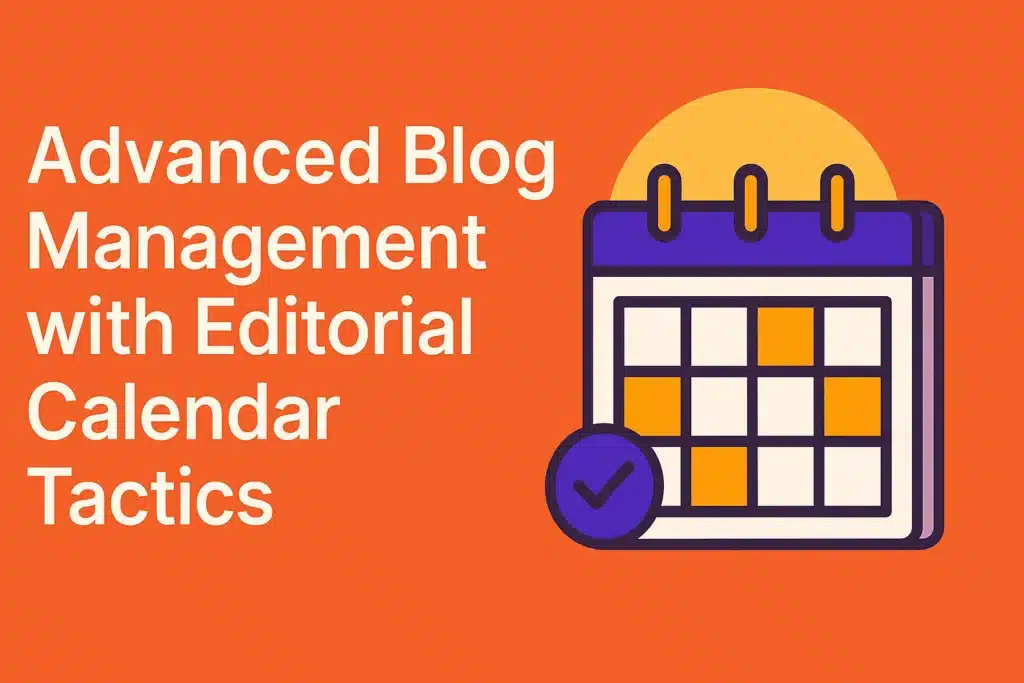Blog management goes beyond more than simply publishing random posts. It demands steady systems, clear goals, and thoughtful schedules. Adults aged 25–49 commonly handle demanding workdays, so proven methods help them manage their blogs, stay organized, use editorial calendars, improve time savings, and keep readers engaged. They also want fast results.
What is Blog Management and Why Does It Matter?
Blog management encompasses maintaining overall content quality, posting schedules, and audience engagement. It matters because structure boosts trust and steady brand presence.
Understanding the basics of blog management
Blog management addresses planning, publishing, and optimizing posts that draw readers. Steadiness is essential, as steadily updated content often drives stronger traffic than sporadic works (Feather Blog), encouraging loyalty.
Key benefits of managing a blog properly
Strong supervision of a blog improves overall trust, smooths out content scheduling, and boosts readership. It widens reach, fosters user trust, and keeps messaging consistent with a brand’s goals for stronger impact.
Challenges of managing blogs without a system
When operations lack structure, they cause missed deadlines and messy pages. Readers grow confused, and search engine rankings often drop. This chaos wastes resources and weakens a blog’s overall trustworthiness.
How to Organize Blog Content for Better Control
Organizing content well stops confusion, saves time, and improves how visitors locate each post. Bloggers can arrange entries by topic or format, label them orderly, and track them in a single location. This strategy helps produce logical collections that satisfy readers’ needs.
Using folders and tags to sort blog content
Folders group broad topics, while tags connect specific themes within posts. Limiting each article to one category keeps archives organized. Tags may number up to four per post, guaranteeing appropriate connections without clutter. This technique boosts link discovery (Slickplan). Readers find older content faster.
Categorizing posts by topic, format, and goals
Clear categories represent a blog’s core themes. Multiple groupings are possible, but selecting one primary category avoids confusion. Internal links within each category guide readers to related pages (TopHatRank). Strong naming structures help new visitors find relevant posts more quickly. Avoid too many subcategories to remain practical.
Planning a content hierarchy for easy access
Organized hierarchies enhance blog-wide teamwork and scheduling. Teams see upcoming posts, prepare social media, and recycle older material. Mapping a clear outline eliminates guesswork. This structure also backs smooth editing workflows (Planable). It helps everyone avoid confusion during busy seasons.
Creating an Editorial Calendar for Blogs
An editorial calendar shows which content to create and when to publish it. It includes topics, deadlines, and team duties. This planning system keeps ideas flowing and reduces any last-minute rush. Bloggers stay informed about their tasks, creating smooth timelines and steady results.
What to include in an editorial calendar
Include content type, topic, owner, estimated publish date, and status. An editorial calendar reveals a long-term direction for posts, connecting them with business aims. Posting steadily helps develop an active audience (Optimizely). Teams can also evaluate planned items against published ones. In this fashion, priorities stay visible.
How often should blog content be published
Some bloggers post weekly, while others aim for multiple entries each week. Research suggests that more frequent publishing can lead to better results, though quality matters more than sheer speed (MasterBlogging). Regular pacing promotes trust and boosts return visits. Overcrowded schedules can reduce focus and steadiness.
Using tools for editorial planning efficiency
Tools such as Optimizely enable clear task assignments, built-in approvals, and data. Teams see each phase instantly, which eases production (Optimizely). Spreadsheets or boards also help smaller teams work together effortlessly. This setup reduces workloads and avoids repeated effort. Everyone saves time monitoring content progress together.
Top Blog Post Scheduling Tips That Work
Scheduling posts increases reach and keeps readers engaged. Steady timing ignites energy, letting followers expect new entries. Seasonal planning and evergreen refreshes fill the calendar across the year. Careful scheduling also opens up time for detailed editing and marketing actions without too much teams.
Why consistency beats frequency
Publishing reliably molds reader habits more successfully than sheer volume. Missing schedules drags down interest, even if you occasionally upload lengthy posts. A reliable pattern helps audiences know when to visit, builds loyalty, and develops a stable core of repeat viewers. This steady approach boosts a blog’s footprint.
Scheduling techniques for seasonal content
Seasonal campaigns demand early prep. For example, start Halloween content in mid-September or holiday gift guides by October (Women Conquer Business). Align updates with common shopping windows. This strategy attracts traffic and connects with users around popular seasons. Aim for themed promotions that match audience interests.
How to recycle evergreen content well
Evergreen topics maintain long-term importance. Sharing them anew boosts engagement and clicks (SmarterQueue). Vary post titles or visuals to keep things fresh. Automated schedulers re-queue those items, reducing content gaps. This approach utilizes timeless subjects to maintain a steady online presence. Readers appreciate the updated touches.
How to Manage a Blog Effectively Day to Day
Daily oversight of a blog includes customized targets, performance checks, team-based roles, practical routines, balanced creation, and methods to avoid burnout. This guide supports writers, editors, and marketers who share duties. It fosters steady progress while maintaining quality across all published materials.
Setting weekly and daily blogging goals
Each week centers on targets for post volume or overall content type. Daily milestones maintain steady output. Bloggers might aim for research on Mondays, drafting on Tuesdays, and editing midweek. Such structure prevents guesswork and guarantees that tasks move forward with clarity and purpose. Schedules help minimize wasted effort.
Tracking performance of your published posts
Analyzing measurements such as visits, shares, inbound links, and leads reveals a blog’s success. Software featuring closed-loop reporting shows exactly conversions from posts (HubSpot). Top-performing entries guide future topics. Routine analysis shows what appeals most, forming content strategy accordingly. Review traffic sources to see where readers come from.
Collaboration and roles within blogging teams
Team members typically include writers, editors, and a blog manager who runs publishing schedules. Clear role boundaries prevent overlap. Document tasks in standardized procedures (Grace+Vine Studios). Set boundaries for communication and track progress in one central tool. Everyone sees deadlines and works more productively together.
Building a realistic blogging routine
Early-morning writing or another set block forms a steady daily rhythm. Some bloggers draft content before checking emails to boost focus (The Little Design Corner). Using a content planner avoids blank-page hesitation. Minor practices build momentum and support a productive habit over time, which fosters commitment and discipline.
Balancing content creation, editing, and marketing
Creators frequently write multiple times weekly, polish drafts, and share them on social networks. This cycle requires careful planning. Overdoing one step endangers the others (Jon Loomer). A balanced workflow sets aside time for production, thorough proofing, and active promotion without skipping steps. It maintains engagement and steadiness.
Avoiding blog burnout with batch production
Batch tasks by writing multiple drafts at once, then edit them together afterward. This method reduces repeated switching. Scheduled breaks renew creative energy. Bloggers who plan wisely avoid burnout (TCN Design Studio). Smaller, regular steps preserve passion over time. They maintain output without sacrificing post quality.
Conclusion
Organizing blog content, scheduling posts, and managing teams around clear aims help shape a successful site. By defining categories, using editorial calendars, and balancing creation with editing, bloggers create steady material that truly clicks with readers. Adopting a routine for research, drafting, and publishing saves time and prevents chaos, while performance tracking identifies areas requiring improvement. Batch production and seasonal planning fill the calendar with fresh ideas, driving steady engagement. Team teamwork clarifies duties, reduces errors, and improves deadlines. Frequent reviews of metrics reveal high-impact topics and help refine future posts. This approach lets individuals maintain an active schedule without feeling overloaded or losing quality. Steadily updated content fosters brand trust and triggers repeat visits. Effective blog management depends on day-to-day setup, strategic planning, and steady action for satisfying both audiences and business goals.
FAQs
What are the best tools for blog post scheduling?
How can I set up an editorial calendar for blogs from scratch?
What strategies help with time management for bloggers?
How often should I update or revise my editorial calendar?
Can I manage multiple blogs with one system?
What are the signs my blog management needs improvement?

Ridam Khare is an SEO strategist with 7+ years of experience specializing in AI-driven content creation. He helps businesses scale high-quality blogs that rank, engage, and convert.



